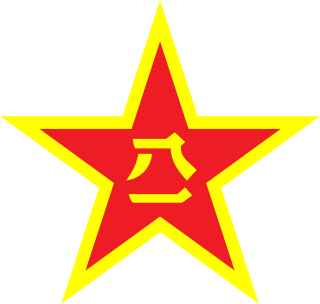The 125th Division was a division deployed by the People's Republic of China during the Chinese Civil War and the Korean War. After series of redesignations and conversions, the division ends its fate as 13th Armored Brigade in April 2017.
The 150th Division, then 11th Garrison Division of Shenyang Military Region was a military formation of the People's Liberation Army of the People's Republic of China.
The 196th Motorized Infantry Brigade is a military formation of the People's Liberation Army of the People's Republic of China. It is one of the "showcase" units of the PLA ground force.
The 197th Army Division, then 5th Garrison Brigade of Beijing Military Region was a military formation of the People's Liberation Army of the People's Republic of China.
The 76th Division was created in February 1949 under the Regulation of the Redesignations of All Organizations and Units of the Army, issued by Central Military Commission on November 1, 1948, basing on the 22nd Division, 8th Column of the Huadong Field Army. Its history can be traced to the 4th Division of Shandong Military District, formed in August 1945.
The Inner Changshan Fort District, former 78th Division, is a military formation of the People's Liberation Army.It's now a coastal defense formation of Jinan Military Region.
The 58th Mechanized Infantry Brigade (lang-zh:机械化步兵第58旅) is a brigade of the People's Liberation Army Ground Force. It is one of the three maneuver elements of the 20th Group Army in the Jinan Military Region. The 58th was previously a division, being converted to a brigade sized formation in 1998.
The 190th Mechanized Infantry Brigade is a military formation of the People's Liberation Army of the People's Republic of China. It is famous for being the first mechanized PLA division.
The 29th Division, now as 56th Motorized Infantry Brigade is a military formation of the People's Liberation Army of the People's Republic of China. It is now one of four mobile brigades of PLA 47th Army. It is the unit that experienced the most times of unit transferring in PLA ground force.
The 189th Division was created in January 1949 under the Regulation of the Redesignations of All Organizations and Units of the Army, issued by Central Military Commission on November 1, 1948, basing on the 9th Brigade, 3rd Column of the Jinchaji Military Region. Its history can be traced to the 5th Military Sub-district of Jinchaji Military Region, formed in March 1940.
The 188th Division was created in January 1949 under the Regulation of the Redesignations of All Organizations and Units of the Army, issued by Central Military Commission on November 1, 1948, basing on the 8th Brigade, 3rd Column of the Jinchaji Military Region. Its history can be traced to the Hebei Guerrilla Army, formed in December 1937.
74th Division(Chinese: 第74师) was created in February 1949 under the Regulation of the Redesignations of All Organizations and Units of the Army, issued by Central Military Commission on November 1, 1948, basing on 20th Division, 7th Column of PLA Huadong Field Army. Its history can be traced to 5th Contingent of New Fourth Army formed in May 1939, which took in several major battles during the Second Sino-Japanese War.
The 63rd Group Army, former 63rd Corps and 63rd Army Corps, was a military formation of China's People's Liberation Army existed from 1949 to 2003.
The 64th Group Army, former 64th Corps and 64th Army Corps, was a military formation of China's People's Liberation Army that existed from 1949 to 1998.
The 192nd Division was created in February 1949 under the Regulation of the Redesignations of All Organizations and Units of the Army, issued by Central Military Commission on November 1, 1948, basing on the 12th Brigade, 4th Column of Huabei Military Region. Its history could be traced back to 2nd Independent Brigade of Jinchaji Military Region, formed in March 1946.
The 193rd Division was created in February 1949 under the Regulation of the Redesignations of All Organizations and Units of the Army, issued by Central Military Commission on November 1, 1948, basing on the 22nd Brigade, 8th Column, 2nd Army Group of Huabei Military Region. Its history could be traced to the famous 1st Division of Chinese Workers' and Peasants' Red Army.
The 184th Division was created in February 1949 under the Regulation of the Redesignations of All Organizations and Units of the Army, issued by Central Military Commission on November 1, 1948, basing on the 43rd Brigade, 15th Column of Huabei Military Region. Its history could be traced to 18th Military Sub-district of Taiyue Military District formed in 1946.
The 11th Division was created in February 1949 under the Regulation of the Redesignations of All Organizations and Units of the Army, issued by Central Military Commission on November 1, 1948, basing on the 3rd Security Brigade, 4th Column of the PLA Northwest Field Army. Its composition can be traced to 84th Division of 27th Corps, Military Division of Shaanxi-Gansu, 29th Corps, Independent Division of Shanganning, 2nd Regiment of Shanganning, 1st Independent Division of Northern Shaanxi and Headquarters, 4th Corps, all parts of Chinese Workers' and Peasants' Red Army.
The 49th Infantry Division(Chinese: 步兵第49师) was a division of the Chinese People's Liberation Army. It was formed in March 1952 and in August designated as a light division of national defense force. It was the second PRC infantry division numbered 49; 49th Division had been disestablished in 1950-51.









